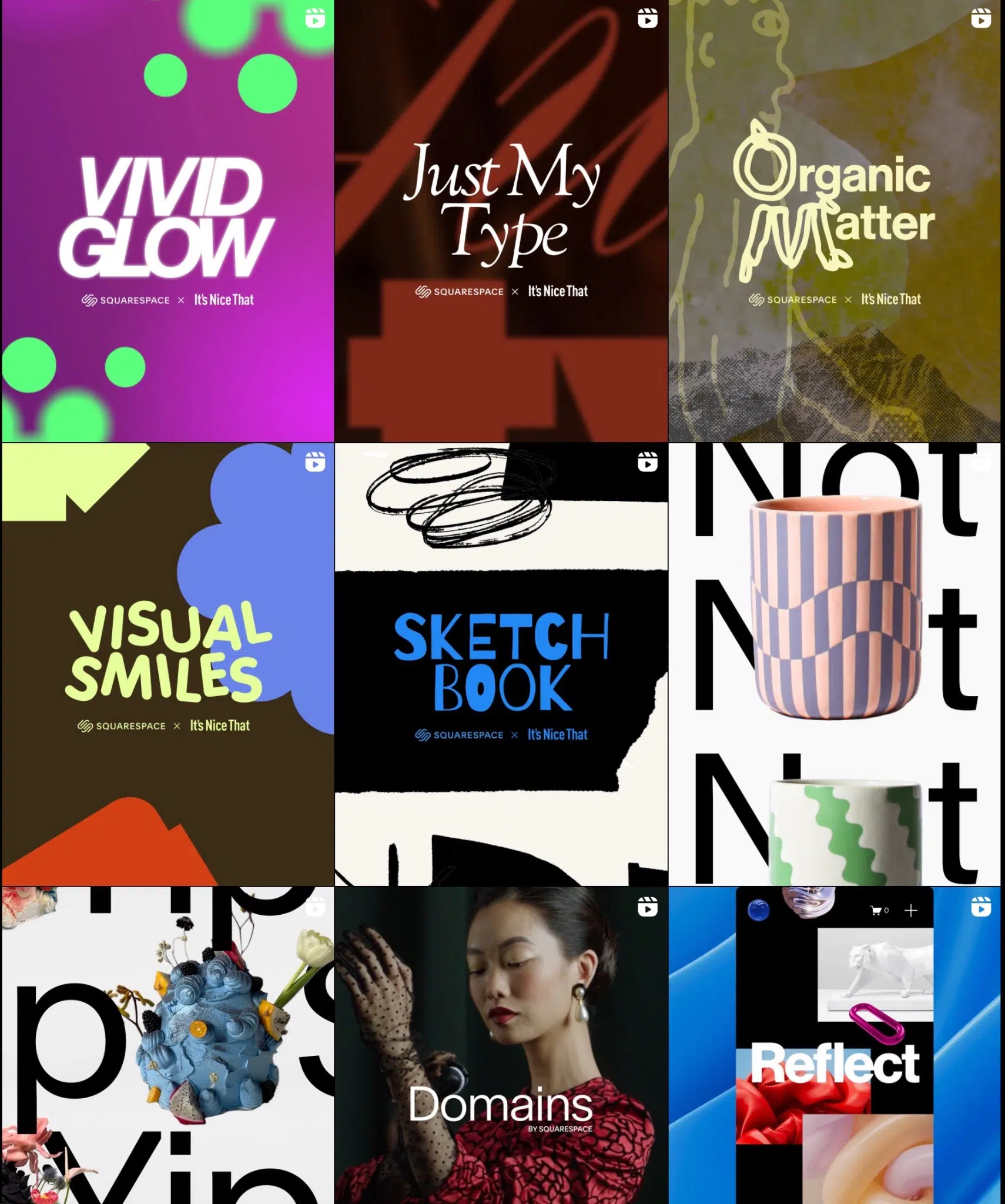Editor’s note: We sat down with Rodolphe Ködderitzsch, General Manager of Social and Creators at Squarespace, to tap into his expert insights on social media for brand growth. This conversation is part of an exciting new series on our blog, so stay tuned for more thought leadership from top executives… 👀
Trends in social media for business growth come and go, so what’s the real foundation of social media success? What’s on the horizon, and how can you beat your competitors to the punch?
For expert advice, we turned to Rodolphe Ködderitzsch, General Manager of Social and Creators at Squarespace. With over two decades of experience scaling growth at digital media organizations, including YouTube and Google, and startups — and sometimes founding them — Ködderitzsch knows that authentic community is what really drives brand growth on social media.
“There’s a crucial difference between an audience and a community: an audience is one-to-many, while a community is many-to-many,” he shares.
“When brands make that shift — from broadcasting at people to building with people — they unlock something much bigger than engagement metrics. They create belonging. And belonging is what sustains communities long after algorithms change or campaigns end.”
Read on for the specific strategies Ködderitzsch and his team use — both for their own business growth on social media, and to help their community of creators, entrepreneurs, and businesses achieve success online.
While each brand’s recipe for social media success will involve a slightly different combination of ingredients, you can implement the strategies Ködderitzsch shares below no matter your industry, budget, audience size, or social media goals.
Can you tell us a bit about your role at Squarespace and how you help shape the brand’s marketing strategy to support creators?
Ködderitzsch: As General Manager of the Social team at Squarespace, I lead our Bio Sites and Unfold products — two entry points that help creators get started on the Squarespace platform.
Unfold equips creators with design-forward tools to craft elevated stories and Reels for social, while Bio Sites reimagines the link-in-bio as a lightweight but powerful storefront for selling products, booking services, and building direct customer relationships. Together, these products serve as the fastest on-ramp for creators into the broader Squarespace ecosystem.
My role spans product, engineering, design, marketing, and customer operations. The way my team is structured allows us to move with startup-like agility while still being aligned with Squarespace’s broader vision: creating a future where everyone can be an entrepreneur.
Where the core Squarespace platform has historically focused on small businesses, our Social team is laser-focused on the creator economy: individuals building brands on social platforms who now need tools to professionalize, monetize, and scale.
The way I think about it is this: creators today are at the intersection of culture and commerce. Our job is to remove friction so they can transform social engagement into sustainable businesses.
By investing in tools that not only help them stand out but also drive measurable outcomes — sales, bookings, email capture — we’re not just supporting creators, we’re helping redefine what entrepreneurship looks like in the social era.
Visual identity is clearly a big focus at Squarespace. How do you use design to build brand trust and credibility with social media content?
Ködderitzsch: At Squarespace, we think about visual identity not just as aesthetics, but as a trust signal.
In a world where anyone can publish anything in seconds, consistency of design is what tells your audience: this brand is credible, intentional, and worth engaging with. Every color, font, and layout choice contributes to that signal.
On social media, the stakes are even higher — feeds are noisy and attention spans are short. Design becomes the fastest way to communicate values before a single word is read. Clean, coherent, and instantly recognizable visuals act as a shorthand for reliability and professionalism, which in turn builds trust.
A great example is Salary Transparent Street, who joined us at one of our creator events. Their entire platform is built on radical openness — literally asking strangers on the street to share their salaries.
The content itself is raw and unscripted, but their use of design gives it structure and credibility. The signature green that anchors their brand appears across their posts, from the on-street microphone to the lower thirds in video clips.
Their typography, framing style, and consistent color palette create instant recognition in a crowded feed. That visual discipline signals to audiences and brands alike that this is not just a viral stunt, but a mission-driven platform. And that’s the sweet spot: when design takes authenticity and amplifies it into long-term trust and loyalty.
How should one balance maintaining that signature look while creating content that works with each channel’s unique environment?
Ködderitzsch: Balancing a signature look with channel-specific content is one of the most important brand challenges today on social. The mistake many brands make is treating consistency and adaptation as opposites. In reality, the strongest brands do both: they lead with a core visual and tonal identity that’s instantly recognizable, and then flex it to feel native to each platform.
Think of your brand identity as the spine — it holds everything together. Your colors, typography, and visual tone should be recognizable no matter where you show up. That’s what builds trust and makes your brand easy to recall in a noisy feed.
But the way you express those elements needs to respect the environment of each channel. A LinkedIn audience will engage with long-form storytelling or thought leadership, while TikTok rewards immediacy, motion, and cultural relevance.
Both can still carry your DNA — you just need to change the lens, not the core.
Creators are masters of this balance. They maintain a consistent style, voice, or aesthetic that makes them recognizable, yet they adapt fluidly to each platform’s culture and format.
Brands should study that playbook: consistency earns recognition, adaptation earns relevance. Together, they compound into credibility.
How can brands leverage influencers or UGC content effectively for their own growth, and to foster community-building within their audience?
Ködderitzsch: User-generated content has become one of the most powerful levers for brand growth because it bridges the gap between marketing and community.
When a customer or a creator chooses to make content about your brand, they’re not just amplifying your message, they’re authenticating it. That authenticity is the currency of the social era.
The brands that succeed with UGC don’t treat it as a one-off campaign tactic; they build systems around it. That means actively designing opportunities for participation, including:
- simple prompts
- creative challenges
- exclusive drops that invite people to put their own stamp on the brand
It also means putting UGC on equal footing with owned content: featuring it in social channels, weaving it into email campaigns, even integrating it into product pages.
Done right, it becomes a loop — community fuels content, content fuels trust, and trust fuels growth.
We’ve seen this firsthand in the creator economy. The most magnetic creators aren’t just broadcasting; they’re creating space for their audience to contribute, remix, and be seen.
Brands can learn from that playbook. The goal isn’t just to get people talking about you — it’s to make them feel like they’re part of your story. When UGC is harnessed in that way, it stops being a marketing asset and becomes a community-building engine.
What’s one common mistake you think brands make when trying to build community on social media — and what should they do instead?
Ködderitzsch: The most common mistake brands make is mistaking audience size for community depth.
They focus on accumulating followers and chasing reach, but they don’t invest in building the meaningful interactions that turn an audience into an actual community.
A million passive followers isn’t as valuable as ten thousand people who feel truly connected to your brand and to one another.
There’s a crucial difference between an audience and a community: an audience is one-to-many, while a community is many-to-many.
Most brands stay stuck in broadcast mode, speaking at people. But real communities emerge when brands channel and enable connections between members — when people aren’t just engaging with you, but with each other. That’s when the dynamic shifts from consumption to co-creation.
Another way to think about this is to recognize that you’re building with your community, not for them. That’s a critical distinction I learned from my friend Bailey Richardson, who led community in the early days of Instagram, at Substack, and now at OpenAI.
Her point has always stuck with me: the healthiest communities are co-authored. When members feel ownership, they don’t just consume — they contribute, defend, and grow the community alongside you.
Brands need to design for participation, not just consumption. That means asking questions, spotlighting voices from the community, and creating rituals or moments where people see themselves reflected in the brand story.
The best communities online aren’t built around a product — they’re built around a shared identity, a set of values, or a cultural moment that people want to be part of. The brand is the catalyst, not the center of gravity.
When brands make that shift — from broadcasting at people to building with people — they unlock something much bigger than engagement metrics. They create belonging. And belonging is what sustains communities long after algorithms change or campaigns end.
If you could leave brands with key lessons for building a social media marketing strategy that drives growth, what would those be?
Ködderitzsch: First, build for outcomes, not vanity.
It’s easy to get caught up in follower counts, likes, and views, but those are surface-level metrics. The real question is: does your social strategy drive meaningful business outcomes—sales, sign-ups, bookings, or deeper customer relationships?
Growth comes from aligning your social activity to measurable objectives, not chasing metrics that look good in a dashboard. Creators have already internalized this: the smartest ones don’t just measure views, they measure conversions and recurring revenue. Brands should do the same.
Second, design for participation, not just consumption.
Social media is no longer a broadcast channel; it’s a participatory medium. The strongest brands create ways for their audience to engage, co-create, and even connect with one another. That’s how you transform an audience into a community, and a community into a growth engine.
Creators are years ahead here — they build comment sections, Discord servers, and subscriber perks that make people feel part of something. Brands need to adopt that same mindset.
And lastly, lead with consistency and authenticity.
Consistency builds trust, and authenticity builds affinity. Brands that show up with a clear visual identity, a recognizable voice, and a genuine point of view stand out in the feed. Plus, they build the kind of loyalty that lasts beyond any one platform or trend.
Look at creators who break through: they’re consistent in their tone, design, and values, and that’s what allows them to expand into new formats and platforms without losing their audience.
Put together, these principles ensure that your social strategy isn’t just about visibility, but about building something that compounds over time: trust, belonging, and growth. And if you want inspiration on how to do it, look closely at creators—they’re already modeling the playbook.
1. Know exactly who you’re speaking to (and speak with them)
As Ködderitzsch says, “When brands make that shift — from broadcasting at people to building with people — they unlock something much bigger than engagement metrics. They create belonging.”
Squarespace is laser-focused on their mission of helping people start and grow their businesses online. This focus becomes even sharper on social media where creators are their main community.
Instead of only thinking about what content you can create for your audience, think about what you can co-create alongside them.
Squarespace’s Renewwwal series highlights their customers’ businesses while building a new website alongside them, and of course showing how easy it is for non-techy people to build a website with Squarespace. It’s a win-win.
2. Inspire your audience, but make it actionable
Squarespace matches motivational stories with practical advice exceptionally well. Inspiration without advice wouldn’t be as effective on its own.
A great example of this is Squarespace’s collaboration with artist Jeff Koons. The campaign featured a landing page along with video and graphics for social media, plus the website Squarespace built with Jeff to showcase his work.
The actionable part? Squarespace users can use the same new template for their websites too.
3. Invest in design
Good design isn’t an afterthought, nor is it the only thing that matters on social media.
“Clean, coherent, and instantly recognizable visuals act as a shorthand for reliability and professionalism, which in turn builds trust,” Ködderitzsch says.
As a snapshot of Squarespace’s post feed, you can feel the creative vibes alongside the recognizable, yet minimal, branding.

Source: @Squarespace on Instagram
4. Consistency + humanity = max brand growth
“Today’s strongest brands combine consistency with a sense of humanity,” Ködderitzsch says.
“We encourage creators and businesses alike to use design systems as a foundation, while leaving room for storytelling, personality, and cultural relevance. When design is both disciplined and alive, it creates not just trust, but affinity.”
We couldn’t agree more.
Save time on planning and publishing, engage your audience, measure ROI, and do everything else you need to do on social media easier and faster with Hootsuite. Try it free today.












